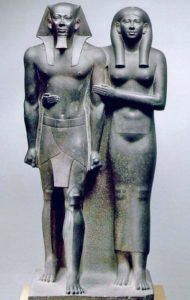

Humanism is the idea that humans can, and should, achieve all that they possibly can in life. It is a view of life which does not count upon any supernatural phenomenon or life after death. Humanism became more interested in themselves than in God influenced by Greeks and Romans studying philosophy and art. For the ancient Greeks, humanism in its many art forms involved the glorification of man as the most important subject in the universe, which is most evident within their sculptures. The Greeks believed that art served as an expression of perfection. Ancient Greeks captured and encapsulated the ideal image of human figures in sculptures. The male sculptures usually carried a muscular and athletic build. The Greeks mostly portrayed their mythological gods in sculpture, to articulate the ideal form of beauty, strength, and power. As an example, the statue of Zeus or Poseidon, god of the sky, shows great stride and extends his left arm forward, while throwing the thunderbolt or the trident, which he held in his right hand. The Romans preferred a naturalistic approach. Their sculptors described historical events and individualized people. Roman sculptures departed from the idealism of the Greek era and captured the most realistic humanism of the figures. The Romans only idealized statues for their divine emperors.
In contrast, Egyptians focused on enshrining the dead and decorating the tombs while Mesopotamians created brightly colored figurines and boldly patterned bowls. They also depicted hierarchy in size, for instance, women are smaller than men. Egyptians display pictures of men and women equally. Both depicted animals on decorative columns.
Egyptian sculptures and paintings followed a rigid formula for representing the human figure which is always depicted with a front view of the eye and shoulders and profile view of head, arms, and legs. In wall paintings, the surface is divided into horizontal bands separated by lines. The leg is turned to the same side as the head, with one foot placed in front of the other. The head is at right angles to the body. Statues are made of hard substances like granite and slate. The pose is always frontal and symmetrical, with arms close to the torso. Every figure whether in paintings or sculptures stands or sits with a formal, rigid posture.

